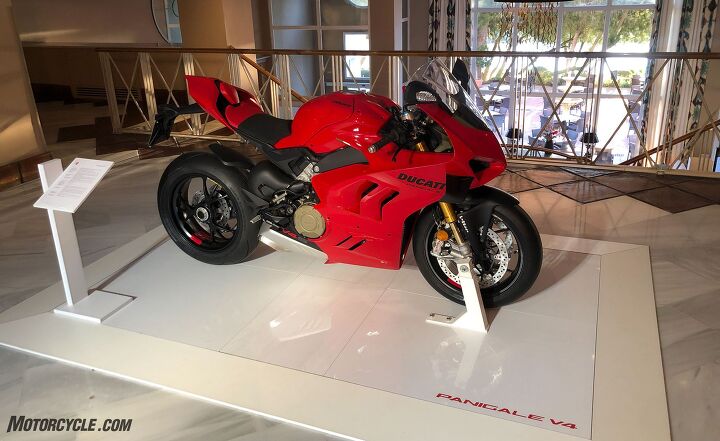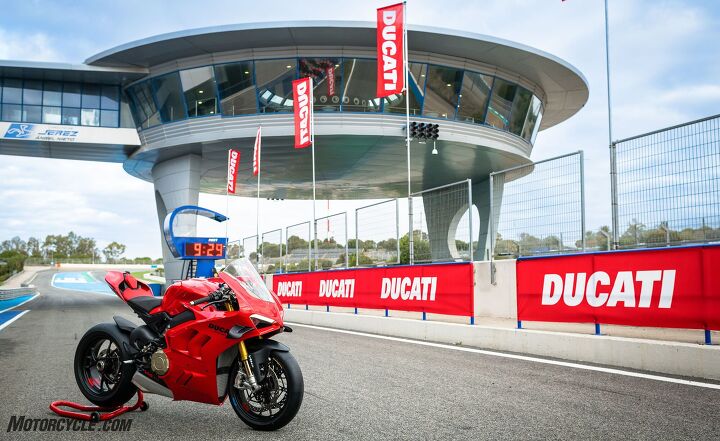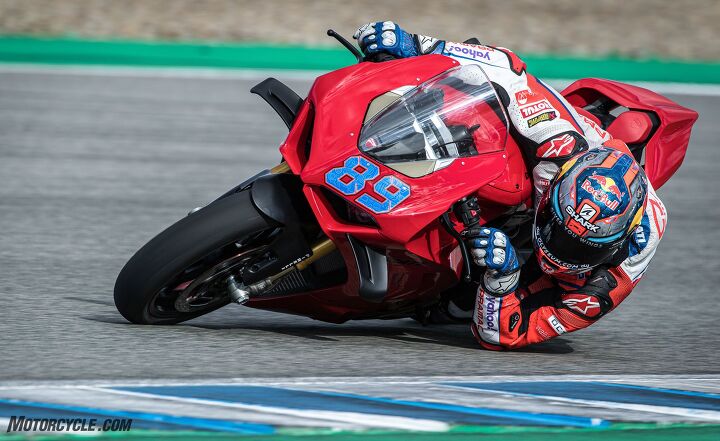Motorsports Racing News & Blog Articles
2022 Ducati Panigale V4 S Review First Ride
When I got the call from Motorcycle.com asking if I’d be available to fly over to the Circuito de Jerez in Spain to test the new 2022 Ducati Panigale V4 S, not only did a certain grin return to my face, but also I was especially intrigued by two things: One, I had just finished participating in a seven bike heavyweight naked shootout with MO (see Battle Royale) with the 2021 Ducati Streetfighter V4 S finishing right up near the top of my personal list. But two, I got the opportunity a few years back to evaluate the 2019 Panigale V4 S Corse at both Laguna Seca and Pirelli’s test circuit, the Autodromo di Pergusa in Sicily. To ride Ducati’s latest Panigale V4 flagship once again, but some two and a half years later, might reveal a few of the special ingredients the Bologna factory has unearthed to help explain this seemingly magic formula they’ve cooked up in both MotoGP and World Superbike.
2022 Ducati Panigale V4 SEditor Score: 98%
| Engine | 20/20 | Suspension | 14.5/15 | Transmission | 10/10 |
| Brakes | 9/10 | Instruments | 5/5 | Ergonomics | 10/10 |
| Appearance | 10/10 | Desirability | 9.5/10 | Value | 10/10 |
| + Highs Ridiculously planted front-end Usable top-shelf electronic aids Best Track EVO TFT to date | – Sighs Nice things cost money Full titanium Akra exhaust @ $7100 hard to live w/o Tires never last forever |
Do you remember how in 2007, when Casey Stoner won the MotoGP World Championship for Ducati, virtually no other rider in the world could swallow that machine?
Chew on this: In 2021, five out of six Ducati riders earned podiums in MotoGP, and five out of five Ducati riders earned podiums in WSBK. In MotoGP, Ducati won Best Manufacturer, Best Team, Best Independent Team, Best Independent Rider, Best MotoGP Rookie, thirty front row starts, twenty-four total MotoGP podiums, and seven wins. So, just what the heck has Ducati been brewing into their pasta sauce?
Spanish Harlem
I arrived at our five star golf course resort hotel the day before the test, and what do I find waiting in the middle of the lobby? A blood red, ridiculously glossy, dead sexy, 2022 Panigale V4 S. “Really, Ducati? I mean, there are elderly men and women still meandering about, innocent civilians, wearing pink or baby blue polo shirts and white shorts. Did you not consider there might be someone among this demographic with a heart condition?”
Seeing this piece of Italian industrial art outside of its natural habitat – a race track, canyon cafe – really did a number on my inner pneuma.
The bike was a dormant alien. A sleeping thing. A living member of a species known to all of us as capable, but potentially deadly. Whoever created it, loved it. Whoever designed this creature belongs to a species known to all of us as capable, but potentially beautiful.
The machine looked like a red rose sitting in a glass case living atop a white piano under a picture light. The walls and floor were glossy white, you see, and it eventually occurred to me, “Even with its thorns, I’d fight for privilege to place this flower between my teeth for the next dance.”
Ma perché? Chi?
Who would buy such a bike, and for what reason? Sure, we can all share in a memory where a wealthy or otherwise well-connected soul arrives at a racy spot one Sunday on just such a machine with well groomed, neatly kept, chicken strips.
“But would an industry leading engineering company like Ducati go through all the trouble to make a technologically advanced super sport bike so a few daisies could attract orchids?” We ask ourselves.
News Flash: In June 2021, Ducati enjoyed its best single month ever, selling 8,598 motorcycles including every model combined, worldwide. In the first six months of 2021, Ducati sold 34,485 total units. Are all these sales to daisies? I think not. More likely; to enthusiasts, collectors, racers, track day connoisseurs, canyon carving specialists, college students, college graduates, commuters, tourers, dual-sport wanna-bees, dual-sport experts, high school dropouts, trust fund babies, cry babies, custom builders, actors, hard workers, lazy fooks, squids, daisies, and many more, I reckon. (Then again, could just be everyone emerging from pandemic mode at once, like cicadas.)
And will all of these customers be riding $30,000 2022 Panigale V4 S’s @ 228hp with its optional $7100 full Ti Akrapovič system (which comes with a matching ECU DP2 flash mapping and high-flow air cleaner, by the way)?
The top three selling Ducatis are actually the Monster, V2 Streetfighter, and V4 Streetfighter.
But, as I learned, the Panigale V4 in many ways is Ducati. It’s why they live. It’s why they develop. It’s why they build, and it’s why they celebrate like maniacs when they win a race.
To the track! But…
In the final days leading up to the 2022 Ducati Panigale V4 S press launch at Jerez, you could find our assembling company of motojournalists keeping one eye on their post-Covid social awkwardness, and the other on a collection of smartphone weather apps; all of which determined to prophesy differing forecasts for our day on track: half with rain, half with zero rain, half with early morning rain but a sunny afternoon, half with a sunny morning but a wet afternoon. “What’s wrong with the rain in Spain?”
We arrived at the circuit, and it was 100% soaking wet. “How much do these bikes cost again?” Was my first thought followed by a question outside of my head, “Ducati brought Pirelli rain slicks with them, how come? Oh, so forty of us can ride these twenty new machines. What could possibly go wrong?” Everyone rode, and I don’t believe a single invited journalist scratched a motorbike while the track was drenched. There must be, um, a few reasons for this.
What’s New, Pussycat?
It might be best if I first started by firing a few bullets at this article (pew pew pew) to relay the major updates between the 2021 and 2022 Panigale V4 S models. The 2022 bike has, in fact, been improved in all areas: Body, Rider Assistance, Chassis, and Engine. A more track oriented Panigale V4 this year, Ducati makes their Panigale V4 less mentally and physically fatiguing to ride (which was already one of the goals with the 2021 model), plus easier to be tuned for any circuit and riding style.
Body:
Reshaped lighter winglets with the same downforce. Wider upper fairing to encapsulate the rider from extreme wind velocities. Increased ventilation throughout the lower fairings. Redirected wind helps cool the quick–shifter; a complex sensitive device. Reshaped fuel tank (with a fuel capacity increase of 0.26 US gallon) has improved ergonomic surfaces for the legs and arms to better support riders under hard braking and when cornering. Newly shaped, roomier, grippier seat is flatter and contoured in the rear to help riders slip their back on the seat under hard braking or when slipstreaming behind the bubble at high speeds. Rider splays more into the bike than on top of it. New styling tweaks by Ducati Centro Stile include a two-tone seat, body and wheel graphics.Rider Assistance:
TFT Dashboard Interfaces with reimagined Street and Track EVO layouts. Both arrangements have a brighter, more visible, and faster shift light in green and over-rev light in red. The Street layout has a revised yellow triangle which indicates vehicle control engagements. The Track EVO layout, borrowed from the $100,000 Superleggera V4, has been improved and is newly homologated for road use on the Panigale V4. Inherently aimed at clearly displaying all of the information necessary while riding on track, the intervention of each riding control is now separated and visibly available to the rider in real-time. This scheme also allows for quick navigation and selection to change each riding control while in motion. There are options to automatically capture, display, and even playback lap times and data acquisition when the optional DDA + GPA hardware is purchased. Four Power Modes are Low, Medium, High, and Full. Low Mode offers a motor output which is limited to a paltry 150 horsepower for a sprightly, if not slightly more realistic pace, during public road executions or restrained track days. Medium and High Modes are revisions from before but with newly tweaked variable torque curves for each individual gear, instead of blocks of gears. A rider might choose these modes when riding on a low grip surface, for example. Full Mode for 2022 is the first time Ducati has allowed customers an unbridled gateway into their Desmosedici Stradale V4 motor’s fuel, sorry, full potential, and defaults the suspension to Fixed. This mode is recommended for race tracks only, and only race tracks with high grip. Four Riding Modes include Race A, Race B, Sport, and Street. The Race A and Race B Modes come default with the most aggressive predictive algorithms possible; checking static Braking, Acceleration, Mid-turn Braking, and Support. Race A has the least intervention by control functions and is designed for tracks with strong acceleration, high grip, and a few pot holes, like Misano. Power Mode defaults to High. Race B offers smoother adjustment, more conservative controls, and suspension settings that can deal with any unevenness. Ideal for tight tracks with bumpy surfaces, less experienced track day riders, and even endurance competitions. Power Mode defaults to High. Sport Mode further increases Traction and Wheelie Control oversight, increased ABS sensitivity, and lessens the abrupt climb to full engine power, using the Medium Power Mode. Street Mode provides a healthy amount of TC, WC, Engine Braking, and rear-wheel lift oversight while still unleashing perfection awesomeness which is the Low Power Mode. Saved Racetrack Presets exist within the TFT menus that offer proven default settings for certain race circuits which Ducati test on, including Laguna Seca, Mugello, and Jerez, to name a few I saw. You can make and save additional ones, as well. Core engine remains the same, but with a new tailpipe, calibration, oil pump and oil circuit, and gearbox. The tailpipe diameter has increased 18% to increase flow. Oil pump and oil circuit have been revised to reduce power loss on the motor. New gearbox matches World Superbike ratios with a taller 1st, 2nd, and 6th gear. Reduced gaps between the first three gears encourage smoother up and down-shifting, makes life easier for the electric shifter, and improves accelerating and when entering a corner. The taller 6th gear permits a higher overall top speed relative to final drive gearing.Chassis:
New pressurized Öhlins NPX 25/30 fork is electronically controlled by Öhlins Smart EC 2.0, has a new shim stack with revised damping. Fork travel has increased by 5mm to 125mm, and the spring rates have dropped from 1.0 to 0.95, but with increased preload. When placed in dynamic modes the fork can act as if intuitive, which also adapts relative to current riding modes. Ducati’s electronic suspension was developed alongside Öhlins. Öhlins electronically controlled steering damper self adjusts in corners to promote easier change of direction while providing increased support in faster, more flowing corners and straights. Swingarm pivot position has been raised 4mm for less squat, easier change of direction, and wider range of suspension adjustments.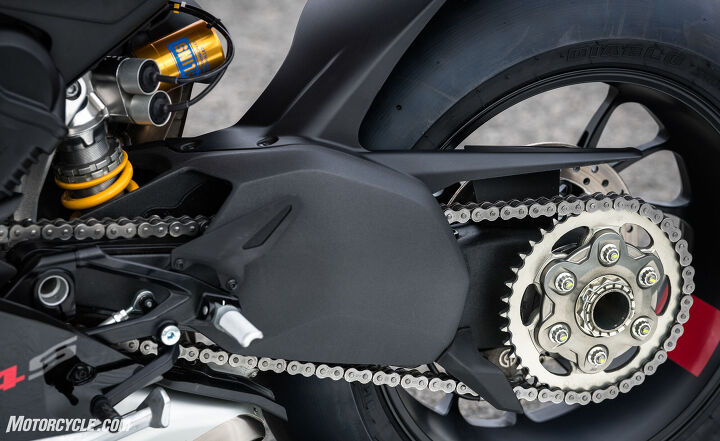
The swingarm pivot was raised 4mm for reduced squat under acceleration and easier directional changes.
I’m cool. I’m Hip. Ah Ducka-Ducka, Out of Water
The first test session of the day was upon us, and the track would indeed be wet. Ducati organizers posted our assigned starting numbers, and wouldn’t ya know? I was being asked to start P1. I’d been chosen as the asshole guinea pig to lead off 19 other Panigale V4 S’s to ‘test the waters’ if you will, onto a sodden Jerez circuit I’d never been to before.
While walking out of the famous flying saucer lounge you always see on tv for Jerez, I leaned into Johann Zarco, who was sitting at a table behind his Apple laptop to ask, “Um, hey, excuse me, bonjour. Could you tell me, please, if you know, I mean, if you could, tell me, if the surface of Jerez is known to have good grip… when it’s wet?”
He raised his head and looked back at me with a stupid expression on his face for way longer a beat than I thought I deserved (Zarco has been my favorite rider in MotoGP since winning his second Moto2 World Championship – mad as a box of frog legs – but seemingly intelligent, super aggressive, plays the piano, and I don’t know, makes me laugh). He responds to me finally with, “Sure.”
Ah, thank God. Perfect, I thought. Then Johann spoke to my back as I walked away from him, “But not the curbs.” Not the curbs? Okay, not the curbs, the curbs are bad. Got it. We’ve got this. I was grateful for the information. “Merci!”
Riding kit on, and we were off.
Straight out of the pits, the 2022 Ducati Panigale V4 S felt right. The reach to the bars, the height of the bars, the height of the seat, the tank, and the foot pegs gave me a sense of confidence and control. On the last Panigale I rode, I felt I was much more ‘on top’ of the bike than inside. By the third corner out of the pits, I was scraping my knee, throwing a rooster tail of water over my wake.
Ah, European tracks. Oh, Spanish tarmac surfaces. How right you feel for motorcycling. There was tons of grip around this MotoGP-sanctioned circuit, and the Pirelli full wets were sticking like glue.
The new pressurized Öhlins front end of this Ducati, with its slightly softer springs, increased travel, new shim stacks, and revised damping, was planted in a way that I don’t recall feeling quite in the same way before. The electronics would adjust the fork softer mid-corner to track the road and follow any imperfections in the surface. This was very confidence inspiring.
As I’d roll on the gas, the rear shock would self-stiffen to give more support and aid the higher swing-arm pivot in allowing me to hold my line on exit or change direction. Remarkable, really.
The new closer-ratio gearbox, with its taller 1st gear, let me upshift with ease then ‘bang bang bang bang’ downshifts like a fork through soggy tiramisu. I would have LOVED to simply flip around the left foot controls to GP-race-shift – which you can do, by the way, on the Panigale V4 without additional hardware – but alas, I had to share my bike with one other journalist who didn’t care for the idea. Merde.
The Riding Mode was set to Street, allowing the 150hp-limited V4 to whirl up beautifully and carry an awesome tune but with only enough power and torque to shoot me out of the corners, over some puddles, then down into the next corner without any unnecessary drama or wasted energy. I was surprised at how tame the bike was responding, as a whole.
I never did push hard enough to activate the ABS brakes in the wet, but that’s not to say I was just messing about, either. I was pushing, trying to learn… everything. I made a mental note, however, that even with the Panigale’s most conservative electronic settings chosen, the ABS was never all over my shit telling me to slow down, slow down, entering every corner. Several other bikes I’ve ridden would have. The Ducati was up for the brisk pace.
Side note: I talk big, and yes, I have a bit of experience riding the bikes. But, about the time I started getting fatigued from patting myself on the back, is when MotoGP Rookie of the Year Jorge Martin comes past me on the brakes, in the rain, with his rear wheel lofted in the air, leg dangling, down into the corner where he proceeded to SCRAPE HIS ELBOW through his reflection. I love moments like this.
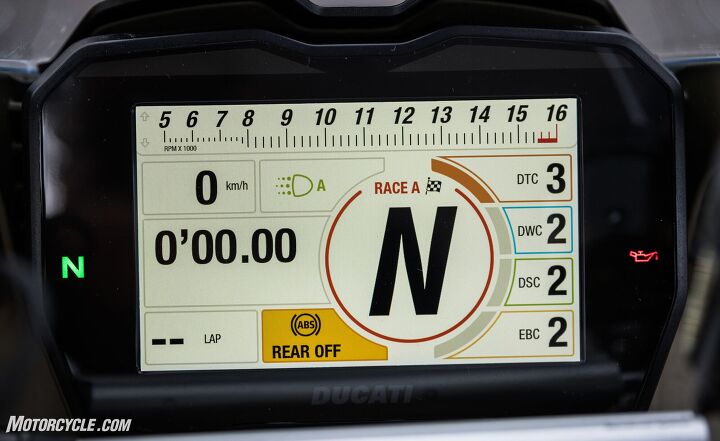
“I could monitor the control systems in real-time and make adjustments in the way I was riding…to try and limit the amount of colors flashing back at me. Over time, and if done correctly, this could help me achieve lower lap times.”
 The Track EVO TFT display was the brightest and easiest to read on track in recent memory. And I could see the colored ‘flash flash flash’ beneath each control system as they each kicked in, in real-time. For example, and read this carefully because I’ve never seen this before; as I exited the corner, the Slide Control swatch/cube on the TFT would begin flashing dark green as the rear wheel was allowed to step out and slide JUST so much, followed by flashing from the dark orange swatch of the Traction Control kept from high-siding me. At that point the bike would begin to wheelie, but it doesn’t because the baby-blue colored swatch/cube takes over flashing as the Wheelie Control system kicks in. Hard on the brakes for the next corner, the Engine Braking color would flash, and so it went.
The Track EVO TFT display was the brightest and easiest to read on track in recent memory. And I could see the colored ‘flash flash flash’ beneath each control system as they each kicked in, in real-time. For example, and read this carefully because I’ve never seen this before; as I exited the corner, the Slide Control swatch/cube on the TFT would begin flashing dark green as the rear wheel was allowed to step out and slide JUST so much, followed by flashing from the dark orange swatch of the Traction Control kept from high-siding me. At that point the bike would begin to wheelie, but it doesn’t because the baby-blue colored swatch/cube takes over flashing as the Wheelie Control system kicks in. Hard on the brakes for the next corner, the Engine Braking color would flash, and so it went.
The punchline to all this is electronic aids, while operating, rob engine power and slow us down, in broad terms. With Ducati’s stratagem, I could monitor the control systems in real-time and make adjustments in the way I was riding; the lines chosen for entry, mid-corner, and exiting, as well as adjust my body position on the bike, to try and limit the amount of colors flashing back at me. Over time, and if done correctly, this could help me achieve lower lap times.
Make sense?
And, did I stay off the curbs? You bet your ass I did.
It’s a new world of motorbiking, party people. As the track continued to dry, I was happy that we got the opportunity to try out Ducati’s cutting edge, modern electronics, under less than ideal grip conditions. I even learned a new race track. I was brave, too. I didn’t cry or nuthin’.
After lunch, the track was completely dry and our same bikes were fitted with brand new, fat, heated racing slicks. The envelopes too were about to get fatter, faster, and more hostile. Could the systems keep up?
Side note: As mentioned before, no one fell in the wet conditions before lunch. But a couple did, after lunch. Please God, don’t let it be me.
I’ll take mine straight up and very dry
Back on track after eating far too many Spanish pastries and doughnuts, and it’s time to evaluate the 2022 Ducati Panigale V4 S in the dry.
As I scrubbed in the new tires and began to approach anything close to Ludicrous Speed, one of the first things I noticed was just how effective the little winglets can be to help to lower your lap times. (I haven’t yet logged a million miles on bikes with winglets, to be fair.)
When approaching, say, 170mph, the amount of downforce which gets applied to the front of your fairing is approximately 30kg of vertical force. In the real world, this means that when you’re ready to pop out your bubble and come down hard on the front brakes, the transition / movement / roll / dive from an accelerating attitude into an extreme decelerating attitude, the front of the chassis already feels somewhat compressed, so it remains more stable.
On the exits especially from the faster corners, the added downforce allows less intrusion from the Wheelie Control which, therefore, robs less power from your engine. The winglets are in the end functional, and you can feel them working.
The second thing I recognized was the terrific feel that the front Brembo Stylema calipers mated with their 330mm rotors provided. They had the power to stop the bike, yes, but also encouraged you to trail-brake deep deep into the corners, over and over again, with myself using only one finger on the lever. At the end of the day, I did notice that most of the Panigale’s front rotors in the garages had turned completely purple from the abuse. For extended periods on track, it might be prudent to swap out the ‘street-comp’ rotors for some thicker T-Drive racing units, or similar.
Again, I rarely went fast enough to require the front ABS to save my ass, but I did overhear Martin saying that, when riding these stock street bikes, he often squeezes on the front lever so viciously, he passes into a realm where his ABS is kicking in, but he refuses to lift on the pressure. So, he just glides into the corners, full brake lever, and the lean-sensitive ABS keeps his bike from low-siding, but very barely. I’d love to work up to and live in that universe, but it’s just not my bike. I don’t reckon Ducati would kick young Jorge out of bed for crashing one of their presser bikes, and he has. Johann has, too.
Now that the circuit had stupid amounts of grip, it was time to unleash the Full potential of its 1103cc, 200hp+ power plant and also see how the electronic controls reacted when set to their most liberal settings.
The answer, in short, is holy hell. This bike is so friggin’ fast, but remains so balanced, it was difficult to remember how any other bike worked. You kinda fall into this inaccurate sense of, “Gosh, isn’t riding a sport bike around a short circuit fun?”
The fact of the matter is, when you combine the Panigale’s counter-rotating crankshaft, the bike’s latest generation 6-axis IMU, the killer TC, the effective WC, the silky electric shifter, the amazing top-shelf Öhlins suspension (dynamic or fixed), the lack of slide from engine braking into the corners, the roomy ergonomics, great wind protection, and all the rest; what you’re left with, in reality, is that one of the most competitive winning factories in MotoGP and World Superbike racing have effectively placed mirrors on something very close to what they’re racing. They then sell them to people for a lousy $30k to ride on a public highway, should they choose.
Case in point; Jorge said he and his stock Pirelli-shod 2022 Panigale V4 S trainer lapped within five (5) seconds of his best lap time while riding his full MotoGP bike on grand prix tires during a test not one week prior around this same course, Jerez.
I hate to have to go
Should a bike this capable be sold to the public for track days, one might ask? Of course. What about sold for road use? Well, if you ask me, I wish that all street bikes would come this capable; the best ABS, best rider aids, lightest weight, amazing brakes, easy to ride, and can accelerate out of harm’s way in any gear at any RPM? I’m a fan of high performing kit, and honestly, I don’t think I’ve ridden a bone stock motorcycle to date that performs as well as this one.
So yeah, the 2022 Ducati Panigale V4 S just might be the best turnkey trackday bike ever built. But, if you do choose to buy one for the street, you’ll just have to behave yourself .
Well done Ducati.
|
In Gear
|
| Specifications | 2022 Ducati Panigale V4 | 2022 Ducati Panigale V4 S |
|---|---|---|
| Type | Desmosedici Stradale 90° V4, counter-rotating crankshaft, 4 Desmodromic timing, 4 valves percylinder, liquid-cooled | |
| Displacement | 1,103 cc | |
| Bore x Stroke | 81 x 53.5 mm | |
| Compression Ratio | 14.0:1 | |
| Power (claimed) | US spec: 210 hp at 12,500 rpm Euro 5 spec: 215.5 hp at 13,000 rpm |
|
| Torque (claimed) | US spec: 90.6 lb-ft. at 11,000 rpm Euro 5 spec: 91.2 lb-ft. at 9,500 rpm |
|
| Fuel Injection | Electronic fuel injection system. Twin injectors per cylinder. Full ride-by-wire elliptical throttle bodies. Variable length intake system | |
| Exhaust | 4-2-1-2 system, with 2 catalytic converters and 4 lambda probes | |
| Gearbox | 6 speed with Ducati Quick Shift (DQS) up/down EVO 2 | |
| Primary Drive | Straight cut gears; Ratio 1.80:1 | |
| Final Drive | Chain 525; Front sprocket 16; Rear sprocket 41 | |
| Clutch | Hydraulically controlled slipper and self-servo wet multiplate clutch. Self bleeding master cylinder. | |
| Frame | Aluminum alloy “Front Frame” with optimized stiffnesses | |
| Front Suspension | Fully adjustable Showa BPF fork 43 mm chromed inner tubes, 4.7 inches fo travel | Öhlins NPX25/30 pressurized 43 mm fully adjustable fork with TiN treatment. Electronic compression and rebound damping adjustment with Öhlins Smart EC 2.0 event-based mode. 4.9 inches of travel. |
| Rear Suspension | Fully adjustable Sachs unit. Aluminum single-sided swingarm, 5.1 inches of travel | Fully adjustable Öhlins TTX36 unit. Electronic compression and rebound damping adjustment with Öhlins Smart EC 2.0 event-based mode. Aluminum single-sided swingarm. 5.1 inches of travel |
| Front Wheel | 5-spokes light alloy 3.50″ x 17″ | 3-spokes forged aluminum alloy 3.50″ x 17″ |
| Rear Wheel | 5-spokes light alloy 6.00” x 17” | 3-spokes forged aluminum alloy 6.00″ x 17″ |
| Front Tire | Pirelli Diablo Supercorsa SP 120/70 ZR17 | |
| Rear Tire | Pirelli Diablo Supercorsa SP 200/60 ZR17 | |
| Front Brake | 2 x 330 mm semi-floating discs, radially mounted Brembo Monobloc Stylema® (M4.30) 4-piston callipers with Bosch Cornering ABS EVO. Self bleeding master cylinder. | |
| Rear Brake | 245 mm disc, 2-piston calliper with Bosch Cornering ABS EVO | |
| Instrumentation | Last generation digital unit with 5″ TFT colour display | |
| Dry Weight | 386 pounds (claimed) | 384 pounds (claimed) |
| Kerb Weight* | 437.6 pounds (claimed) | 431 pounds (claimed) |
| Seat Height | 850 mm (33.5 in) | |
| Wheelbase | 1.469 mm (57.8 in) | |
| Rake | 24.5° | |
| Trail | 100 mm (3.94 in) | |
| Fuel Tank Capacity | 17 l – 4.49 gallon (US) | |
| Number Of Seats | Dual seats | |
| Safety Equipment | Riding Modes, Power Modes, Bosch Cornering ABS EVO, Ducati Traction Control (DTC) EVO 3, Ducati Wheelie Control (DWC) EVO, Ducati Slide Control (DSC), Engine Brake Control (EBC) EVO, Auto tire calibration | |
| Standard Equipment | Ducati Power Launch (DPL), Ducati Quick Shift (DQS) up/down EVO 2, Full LED lighting with Daytime Running Light (DRL), Sachs steering damper, Quick adjustment buttons, Auto-off indicators, Chain guard | Ducati Power Launch (DPL), Ducati Quick Shift (DQS) up/down EVO 2, Full LED lighting with Daytime Running Light (DRL), Ducati Electronic Suspension (DES) EVO with Öhlins suspension and steering damper, Quick adjustment buttons, Lithium-ion battery, Auto-off indicators, Marchesini aluminum forged wheels, Racing style handle grips, Chain guard |
| Additional Equipment | Passenger seat and footpegs kit | |
| Ready For | Ducati Data Analyser+ (DDA+) with GPS module, Ducati Multimedia System (DMS), Anti-theft, Heated grips | |
| Warranty | 24 months unlimited mileage | |
| Maintenance Service Intervals | 12,000 km (7,500 mi) / 12 months | |
| Valve Clearance Check | 24,000 km (15,000 mi) | |


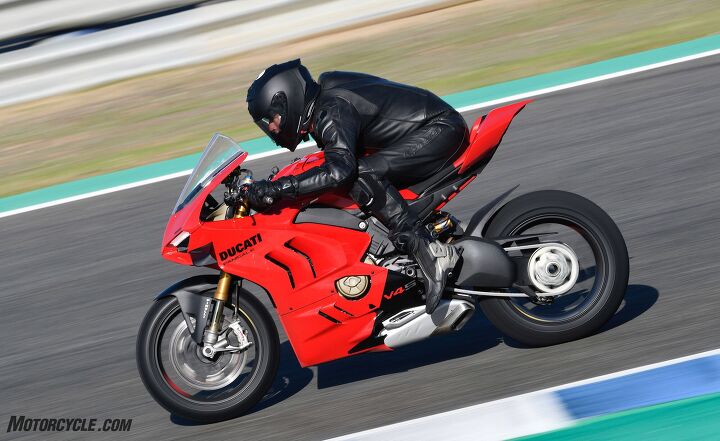


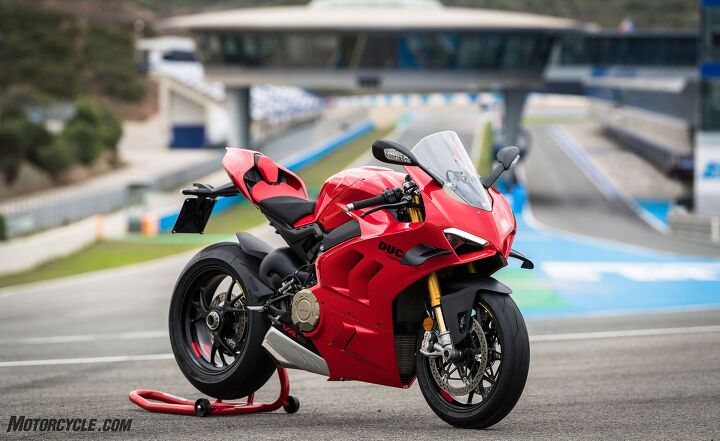
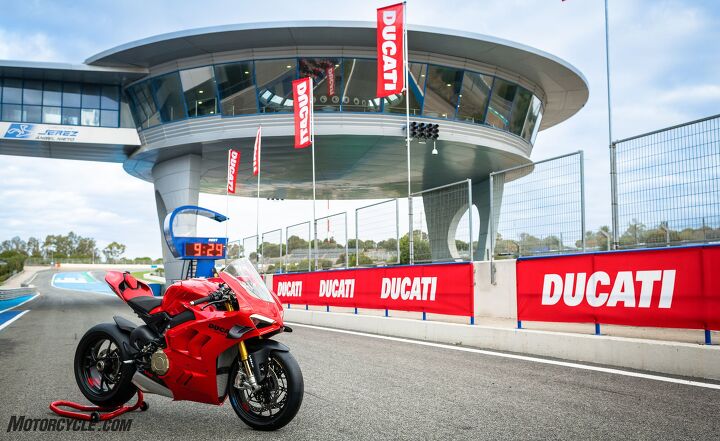
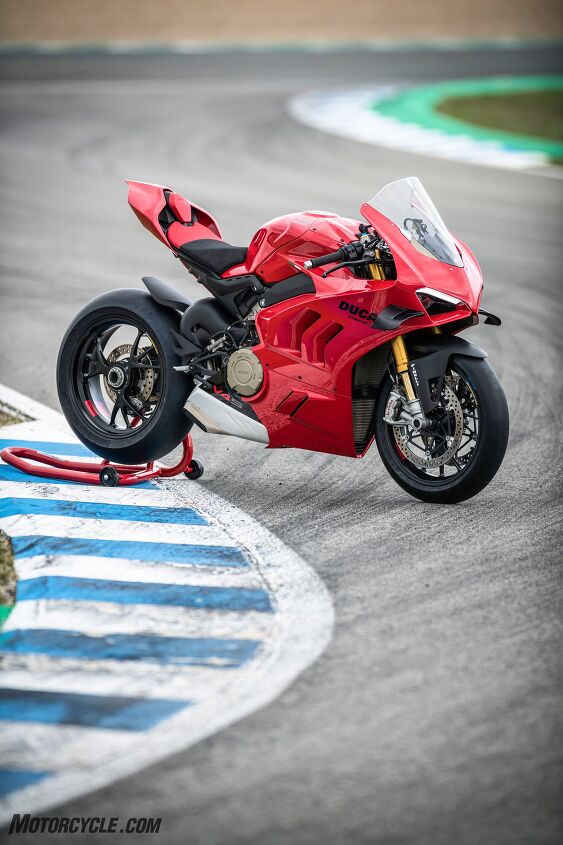
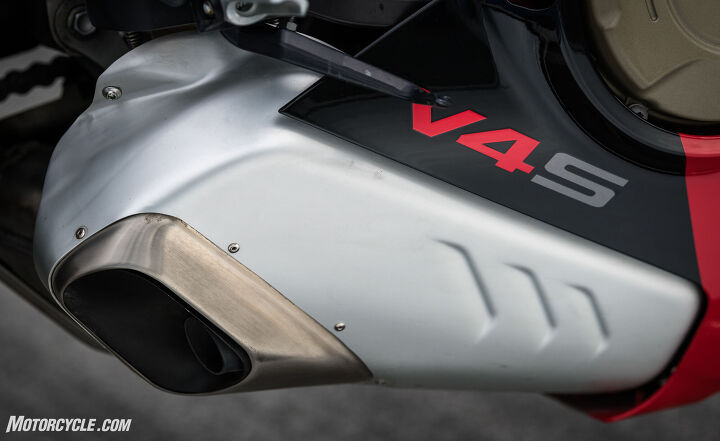

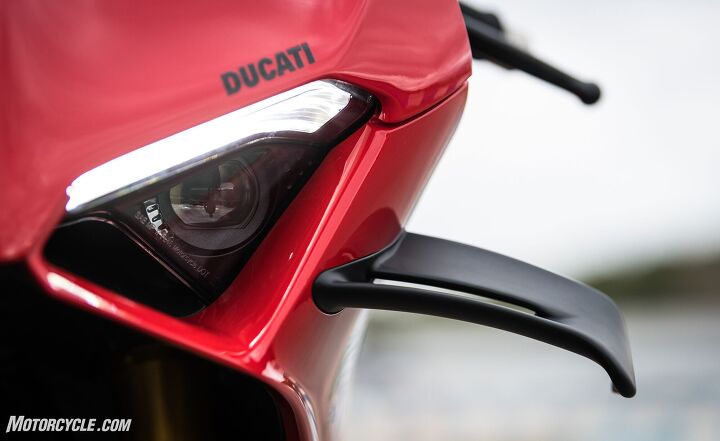




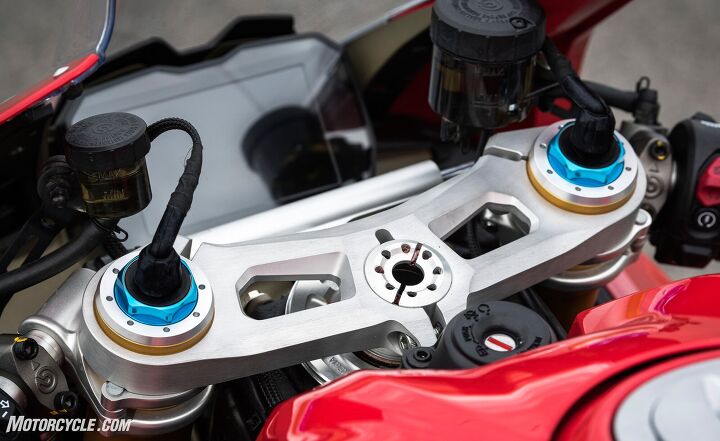
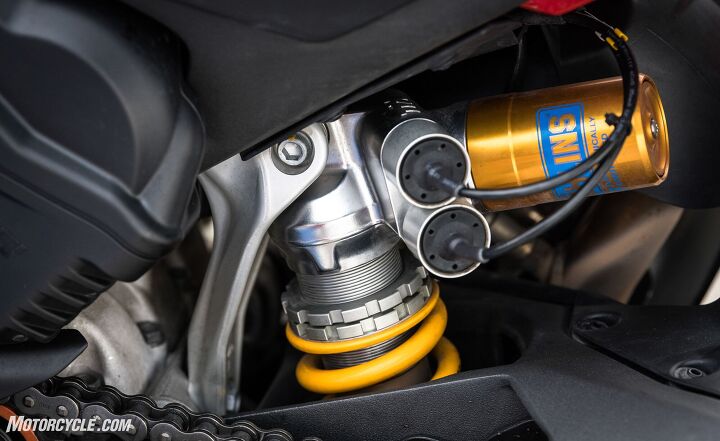

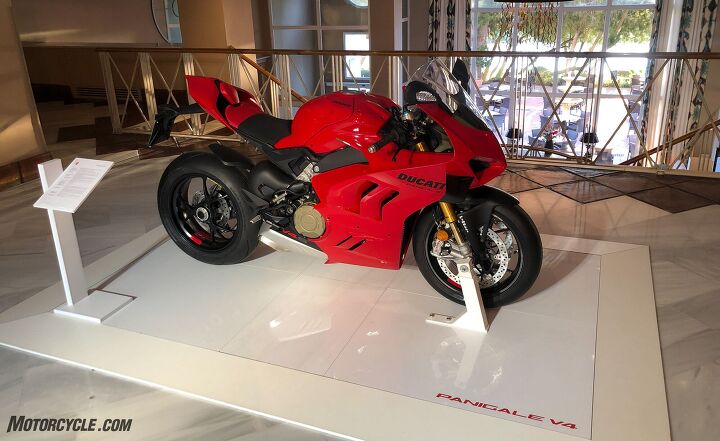
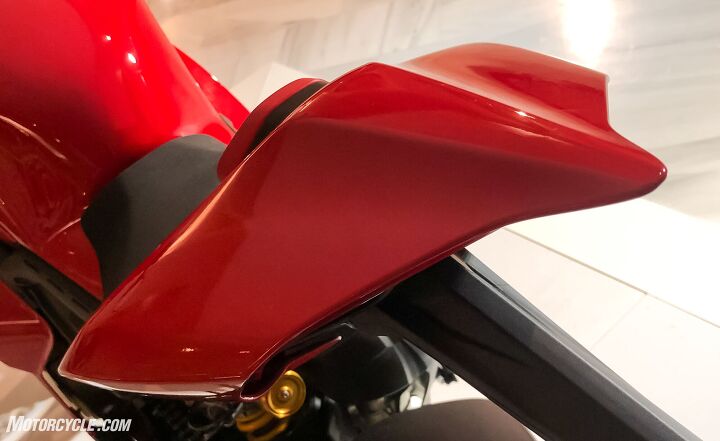

We are committed to finding, researching, and recommending the best products. We earn commissions from purchases you make using the retail links in our product reviews. Learn more about how this works.
Become a Motorcycle.com insider. Get the latest motorcycle news first by subscribing to our newsletter here.
The post 2022 Ducati Panigale V4 S Review – First Ride appeared first on Motorcycle.com.
Copyright
© Motorcycle.com


